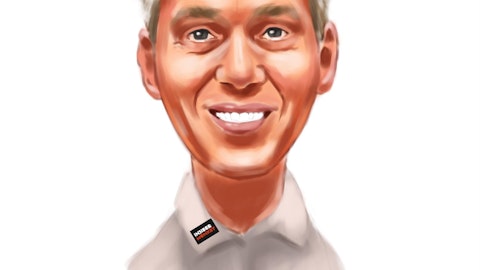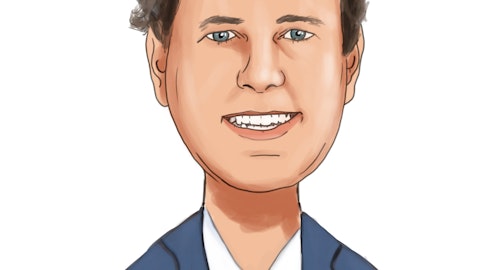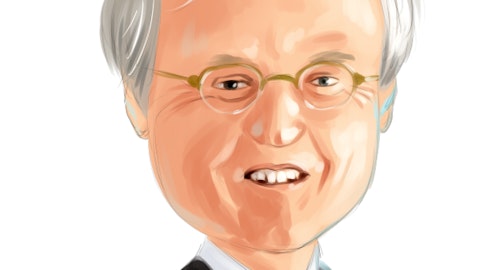Anthony Chukumba: That is helpful. Thank you. And then just one quick follow-up. Can you just give us an update in terms of integrating the Aaron’s lease-to-own solution into BrandsMart stores. I know it’s in the stores, but if I — my understanding is that you want to make some sort of refinements to it? So I was just wondering if we can get an update there.
Steve Olsen: Sure. Hi, Anthony. This is Steve. Today, we’re pleased with the performance and we would say we’re ahead of our internal expectations on the key LTO metrics, things like portfolio size, renewal rate, and just the overall demand coming into BrandsMart leasing. Just to remind you, we rolled it out in May of last year. So we’re just about a year into that rollout and we’re making continuous improvements both from a process standpoint in the systems and we feel we’re well positioned if and when the credit tightening above us occurs.
Douglas Lindsay: Yes, Anthony, I’d just add, I mean, the team has done a fantastic job to launch that, and we believe there’s additional operational enhancements to gain more market share there and streamline the process. We’re sort of early innings on that, but we’re optimistic about the future of that synergy.
Anthony Chukumba: That’s very helpful. Thank you.
Operator: The next question today is from the line of Bobby Griffin of Raymond James. Bobby, your line is now open. Please proceed.
Bobby Griffin: Good morning, everybody. Thanks for taking my questions. I guess first Kelly, just on the guidance, just trying to unpack the changes a little bit more. Was the upside with the higher now Aaron’s core guidance just for the upside during the quarter or did the expectations for that segment of the business change over the remaining nine months that you guys have to report?
Kelly Wall: Yes. So the increase on the earnings side there does reflect Q1, but it also reflects the larger lease portfolio size we have going into the beginning of Q2. And that carrying through the remainder of the year relative to our initial expectations. The other thing — two areas where we’ve updated our view one on write-offs. I know, but I hit it, Douglas if you have also hit on this as well, right. Great, continued momentum in the benefit of our lease decisioning changes over the last year. And so if you see it clearly in the 32-plus day non-renewal rate that we’re now disclosing and tracking that over the last year, as compared to the prior year. So continued benefit of the write-offs is part of what we’re continuing to factor in, as well as the cost control initiatives that we’ve really leaned into this year we’re seeing good results there. So all three of those put together is helping contribute to that increase on the Aaron’s business side.
Bobby Griffin: Now the — I guess the counter is with the portfolio side coming in better, write-offs coming in better, the cost control only moving $5 million. Is there any offset there or is it just some conservatism and then obviously the consumer is still very tough to predict. We don’t quite know what’s going to happen with trade down. Just trying to kind of unpack, if it does seem like the core leasing business has some good developments taking place now versus trends over the last 12 to 18 months?
Douglas Lindsay: Yes, hey, Bobby, it’s Douglas. I mean, I would say the offset to that is demand pressure. We continue to see demand pressure in the first quarter and that has persisted through April. So we have tweaked our demand assumptions down in the first-half of the year incrementally. From our original outlook, leaving the second-half of the year. Alone as we think, while the second-half of the year will be down year-over-year, there’s — will be slight improvement there relatively speaking. But we continue to look at industry data. We look at what we’re seeing in our data so far this year and are assessing how much to pull forward the demand and how long will that will persist relative to the product life cycle. So we’ve taken all that into account. So Kelly outlined the three positives, I would say that’s the pressure on the business right now. And there’s a pressure on BrandsMart and on Aaron’s.
Steve Olsen: Yes. And Bob, to your point, right? We are not assuming any trade down in credit, so we’re at to happen that could, kind of, counteract balance that demand pressure that Douglas had mentioned before. So just another thing to kind of keep in mind in terms of potential upside going forward?
Douglas Lindsay: Yes, and I would say the last thing is — and is based on Kyle’s original questions to the extent we continue to see lower write-offs, we reduced our lease affordable rates by several hundred basis points year-over-year. And to the extent those low write-offs continue, that is also an opportunity for us. If we were to loosen there
Bobby Griffin: Thank you. That’s helpful too. And I guess Kelly, on the subject of trade down, none assumed going forward. Have you seen any signs that it might be coming or did you see a little bit in 1Q that gives you kind of hopes that maybe we’re entering this period that credit actually is going to tighten a tiny bit either from an application standpoint or some — your customer demand that are applying or anything like that?
Douglas Lindsay: Yes, Bobby, this is Douglas. I would say as of right now, we’re not seeing an increase in demand. From credit tightening above us either at Aaron’s or BrandsMart, it’s really tough to gauge what’s going on right now. It seems to me things are getting tougher with the prime and near prime consumer. And as Kelly said, should credit tighten above us, default rates increase credit get restricted, we believe that our market will expand. We get external data every day. We run that through our lease decision and committee and we’re looking at what’s coming into our funnel. We have not seen evidence of that. We see some slight evidence of demand coming in from our peer group, I would say, with lower approval rates, but not necessarily from above us.
We do data that comes through BrandsMart and we’re looking that as well in BrandsMart leasing. So we continue to focus on the external factors and how they may influence that going forward gas prices, housing prices, food prices are major factors for our customer. And of course, the near prime consumer is their savings rates diminish and credit increases, those will be important factors. But we’ll continue to keep you updated on that.
Bobby Griffin: Absolutely. Well, I appreciate the details. Best of luck here going forward.
Douglas Lindsay: Thank you.
Kelly Wall: Thanks, Bobby.
Operator: And the next question is from the line of Scot Ciccarelli of Truist. Scot, please go ahead. Your line is open.
Joe Chalhoub: Hi, good morning, guys. This is Joe Chalhoub on for Scot. Thanks for taking my question. I just wanted to dive a little deeper into the 170 basis point sequential improvement in write-offs? And how we should think about the full-year guidance? I think last time you guys said 5.5% to 6.5% for this year, and then longer term, kind of, getting back to the 5% to 6% range. Just wanted to see if those changed at all?





